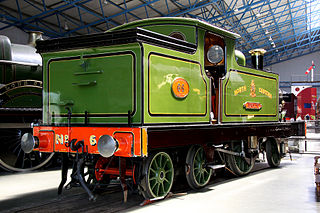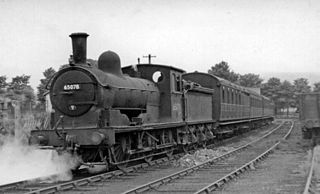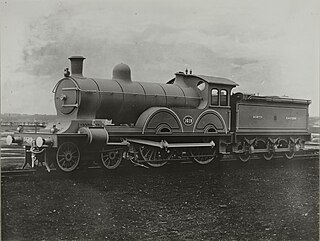
Sir Vincent Litchfield Raven, KBE was an English railway engineer, and was chief mechanical engineer of the North Eastern Railway from 1910 to 1922.

In Whyte notation, a 2-2-4T is a steam locomotive that has two leading wheels followed by two coupled driving wheels and four trailing wheels. This was an unusual wheel arrangement, only used on a few specialised locomotives. This wheel arrangement is only used for tank locomotives.

Under the Whyte notation for the classification of steam locomotives, 0-4-4 represents the wheel arrangement of no leading wheels, four powered and coupled driving wheels on two axles, and four trailing wheels on two axles. This type was only used for tank locomotives.

The North Eastern Railway (NER) Class C1, was a class of 0-6-0 freight locomotives designed by T.W. Worsdell. They were used throughout the NER system, although particularly in Teesside between 1886 and 1962.

The NER Class ES1 was a class of two steeplecab electric locomotives commissioned by the North Eastern Railway in 1902.

The North Eastern Railway (NER) Class H, classified as Class Y7 by the London and North Eastern Railway (LNER) is a class of 0-4-0T steam locomotives designed for shunting.

The North Eastern Railway Class E1, classified as Class J72 by the London and North Eastern Railway (LNER), is a class of small 0-6-0T steam locomotives designed by Wilson Worsdell for shunting. They had inside cylinders and Stephenson valve gear.

The North Eastern Railway Class M1 is a class of 4-4-0 steam locomotive, designed by Wilson Worsdell. 20 initial engines were built, then 30 further units were built, designated Class Q.

The North Eastern Railway (NER) Bogie Tank Passenger (BTP) locomotives were designed by Edward Fletcher in 1873. The locomotives were for hauling passenger services on branch lines. They had an 0-4-4 wheel layout and a total of 124 locomotives were built. They were designated G6 by the London and North Eastern Railway (LNER).

The NER Class X was a class of 4-8-0T tank locomotive designed by Wilson Worsdell for the North Eastern Railway. They were intended for use as powerful shunting engines to arrange and move coal wagons for loading into ships. In total 15 were built, 10 by the NER between 1909 and 1910, and a further five in 1925 by the London and North Eastern Railway (LNER). They had three cylinders with divided drive: the inside cylinder driving the leading axle, the outside cylinders driving the centre.

The Class EF1 was a class of electrically powered locomotives built by the North Eastern Railway from 1914. They were built to haul coal trains from the mines at Shildon to the docks at Middlesbrough. In common with other LNER electric locomotives, no classification was given to these locomotives until 4 October 1945, when nos. 3-12 were all classified EB1 although only no. 11 was actually modified for banking. It was expected that all the locomotives would be similarly modified, but this did not happen, and the remaining locos were classified as EF1.

The NER Class 3CC was a 4-4-0 steam locomotive designed by Wilson Worsdell for the North Eastern Railway and built in 1893. Only one was built and it was a compound expansion version of the simple expansion NER Class M1. The 3CC was originally classified M but was re-classified 3CC in 1914, at the same time as the M1 was re-classified M.

The NER Class O was a class of 0-4-4T steam locomotives of the North Eastern Railway, designed by the company's Chief Engineer, Wilson Worsdell. They all survived into British Railways ownership in 1948 and their BR numbers were 67240-67349. They were withdrawn between 1950 and 1958.
The NER Class L was a class of 0-6-0T steam locomotives of the North Eastern Railway. They were a specialised design, intended for use on the Redheugh and Quayside banks on either side of the River Tyne. They were replaced on the Quayside branch by NER Class ES1 electric locomotives in 1905 but were re-allocated to other duties.

The NER Class 290 was a class of 0-6-0T steam locomotives of the North Eastern Railway (NER), rebuilt from an earlier class of 0-4-4T, the NER Bogie Tank Passenger.

The NER B and B1 Classes were two classes of 0-6-2 tank locomotives designed by Thomas William Worsdell for heavy freight and mineral on the North Eastern Railway, introduced in 1886. They were tank engine versions of the NER C1 Class 0-6-0, using both simple expansion and also the von Borries configuration for two-cylinder compound locomotives. Both types were later rebuilt using superheated steam and the compounds were also rebuilt as simple expansion locomotives, and eventually formed a single class. Many of the superheated locomotives were also later returned to saturated steam as their original boilers wore out. As a result the classes have had a very complex mechanical history.
The North Eastern Railway was formed by merger in 1854 and merged into the London and North Eastern Railway at the grouping in 1923. Between those dates five men held the post of Locomotive Superintendent.

The NER Class R1 was a class of 4-4-0 steam locomotives of the North Eastern Railway. The class was designed by Wilson Worsdell and built from 1908 to 1909.
The NER Class N was a class of 0-6-2 tank locomotives of the North Eastern Railway. It was designed by Wilson Worsdell and introduced in 1893.

The NER Class V was a class of twenty steam locomotives of the 4-4-2 wheel arrangement. They were designed by Wilson Worsdell for the North Eastern Railway (NER) as express passenger locomotives.

















